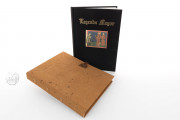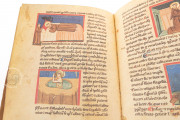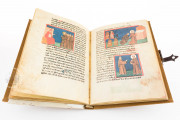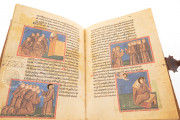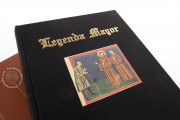Long considered a literary masterpiece of medieval hagiography, the Major Legend of St. Bonaventure introduces readers to St. Francis through the eyes of a friend and first hand-witness. Bonaventure was given the task of composing a new and authoritative life of St. Francis at the General Chapter in Narbonne in 1260. Numerous copies were quickly made after delivering his product in 1262, and the text was declared official in 1266.
Rather than flowing as a strict biography, per se, St. Bonaventure's Latin text alternates between narrative and thematic content in fifteen chapters and also charts the birth and growth of the Franciscan order.
This particular late thirteenth-, early fourteenth-century copy was abundantly illustrated with 164 miniatures in a rich range of colors with gold highlights throughout.
Framed in thick red frames and set on blue backgrounds with white filigree flourishes on their perimeters, experts associate the miniatures' style with Umbrian illumination, suggesting the manuscript was an Umbrian product.
Mapping the Franciscan Habit
Several scholars have noted the compositional similarities of the miniatures with Giotto's fresco-cycle at the Superior Basilica of San Francisco in the saint's hometown of Assisi.
Two or three painters were likely responsible for illuminating the book, and although it is unclear whether they had any association with Giotto or his workshop, the miniatures make clear reference to the monumental frescoes.
A total of 686 figures are illustrated throughout the book, 429 of which reproduce the evolution of the Franciscan habit. This appeared to be an important aspect for readers, as several commented upon this in the book's margins.
A Tumultuous History
The manuscript's numerous marginal annotations demonstrate that it was read and consulted by many. Thanks to the additional quire at its beginning, most of its exciting history can be reconstructed.
While it should have stayed in a northern Italian convent in Alba, the manuscript went into the hands of Minister General, Fr. Juan de Nápoles, in 1648. It was passed into the possession of Fr. Pedro Manero in 1651 but mysteriously disappeared shortly thereafter, only to turn up again three years later in a shipment of books from Rome.
Thereafter, the manuscript was entrusted to the Counts of Chinchón, distinguished benefactors of the Order, so that they could ensure its safety. In the nineteenth century, however, the famous codex returned to the hands of the general minister, Fr. Luis Iglesias, who gave it to the historian of the Order, Fr. José María Laso de Vega.
Upon the suppression of several monastic institutions at the beginning of the Carlist Wars, Fr. José María Laso de Vega left the convent of San Francisco in Madrid with the codex in his pocket and put it in the care of his relatives upon his death.
The book turned up only a hundred years later in 1937 when it was returned to the Order. Although it was missing six leaves at this point (it originally comprised eighty folios), the codex was deposited in the archives of the Convento Franciscano Cardenal Cisneros, where it remains today.
We have 2 facsimiles of the manuscript "Madrid Life of Saint Francis":
- Legenda Maior facsimile edition published by AyN Ediciones, 2001
- Leyenda Mayor San Buenaventura facsimile edition published by Ars Magna, 2001


